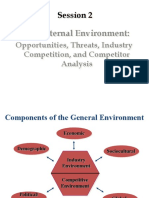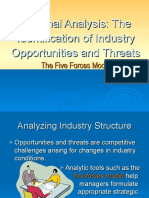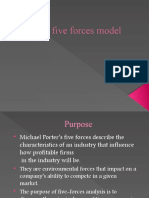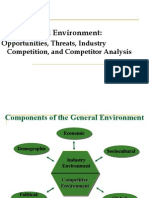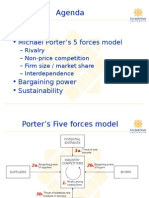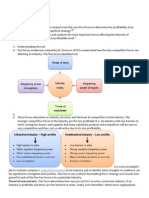Porter's Five Forces Model: Competitor Profiling & Analysis
Uploaded by
Sajad AzeezPorter's Five Forces Model: Competitor Profiling & Analysis
Uploaded by
Sajad AzeezPorter's five forces model
Estimating their reaction pattern & competitive position
Competitor Profiling & Analysis
Essential component of corporate strategy
An assessment of Strengths & Weaknesses of current & potential
competitors
Analysis provides both an offensive & defensive strategic context to
identify opportunities & threats
Competitor profiling combines all the relevant sources of competitor
analysis into one framework in the support of efficient & effective
strategy formulation, implementation, monitoring & adjustment
Michael Porter
University Professor at Harvard Business School
Academic interests in management & economics
Main academic objectives focus on how a firm or a region can build a
competitive advantage and develop competitive strategy.
One of his most significant contributions is the five forces analysis
Porter's five forces model
Michael Porter's famous Five Forces of Competitive Position model
provides a simple perspective for
Assessing & Analyzing the competitive strength & position of a
corporation/ business organization
Purpose of the Five Forces model
Environmental forces that impact on a companys ability to compete in a
given market
The purpose of five-forces analysis is
Diagnose the principal competitive pressures in a market
Assess how strong & important each one is
The five forces determine the competitive intensity & attractiveness of a
market
Five Forces that determine the attractiveness of a Market/ Market
segment in the long-run
Industry Competitors
Potential Entrants
Substitutes
Buyers
Suppliers
Porter also refers to the Threats these forces pose
Threats posed by these factors in business strategy
1. Threat of intense Segment Rivalry
2. Threat of new Market entrants
3. Threat of Substitute Products
4. Threat of Bargaining power of Buyers
5. Threat of suppliers growing Bargaining Power
1. Suppliers
Suppliers' comprises all sources for inputs needed in order to
provide goods/ services
Suppliers of raw materials, components, labor, & services to the firm
can be a source of power over the firm
Suppliers may refuse to work with the firm, or e.g. charge excessively
high prices for unique resources
The Bargaining Power of Suppliers is high when
1. Dominated by a few large companies & more concentrated than
industry it sells to. (Eg. Pharma. Industrys relationship with
hospitals)
2. Switching costs from one supplier to another are high. Eg.
Microsoft Ltd. Relationship with PC manufacturers
3. Degree of differentiation of inputs Unique inputs
4. No substitutes for the particular input
5. Employee solidarity - Eg. organized labor unions
6. Threat of integrating forward into industrys business Eg.
Supplier firm acquires a distributor
7. Cost of inputs relative to selling price of the product
2. Buyers
The bargaining power of customers/ Buyers - the market of
outputs
Bargaining power of customers determines how much customers can
impose pressure on margins & volumes.
Also affects the customer's sensitivity to price changes
A buyer/ customer group is powerful if
1. Buy large volumes & there is a concentration of buyer Eg. Indian Army
purchasing from defense contractors (Defense Expo in New Delhi)
2. Supplying industry comprises of a large number of small operators
(fragmented)
3. Products purchased from industry are standard/ undifferentiated. Can be
replaced by substitutes
4. Switching to an alternative product is relatively simple & not related to
high costs
5. Input materials purchased from industry form a component of the buyers
product, representing a significant fraction of its cost
6. Possibility for the customer integrating backwards - Customers could
produce the product themselves Eg. Large Auto manufacturers buying
out the tire producers
3. Threat of New Entrants
Barriers to entry
1. Economies of scale (minimum size requirements for profitable
operations)
2. Cost advantages independent of size of firm
3. Product differentiation
4. High initial investments
5. Brand loyalty of customers
6. Protected intellectual property like patents, licenses etc,
7. Scarcity of important resources, e.g. qualified expert staff
8. Capital requirements & Access to raw materials is controlled by existing
players
9. Access to distribution channels - controlled by existing players
10. Government policy
4. Threat from Substitute Products
1. A threat from substitutes exists if there are alternative products with
lower prices of better performance parameters for the same purpose
2. Potentially attract a significant proportion of market volume
3. Reduce the potential sales volume for existing players limit profits
4. This category also relates to complementary products
5. Eg - PC industry flooded with laptops
5. Competitive Rivalry between Existing Players
Intensity of competition between the existing players (companies) in an
industry makes it unattractive
High competitive pressure results in pressure on prices (price wars),
advertising battles new product introductions
Eg. Mobile phone Industry, Aerated beverage industry
Competition between existing players is likely to be high
when
1. Numerous competitors or they are roughly equal in size & power
2. Players have similar strategies
3. There is not much differentiation between players and their products,
hence, there is price competition
4. High fixed costs or perishable product
5. Low market growth rates (growth of a particular company is possible
only at the expense of a competitor)
6. Barriers for exit are high (e.g. expensive and highly specialized
equipment)
Limitations of the Porter's Model
The model assumes a classic perfect market
Best applicable for analysis of simple market structures
Comprehensive description & analysis of all five forces gets very difficult
in complex industries with multiple interrelations, product groups, by-
products and segments
Traditional strategy models, such as Michael Porter's five forces model,
focus on the company's external competitive environment. Most of them
do not attempt to look inside the company
The more an industry is regulated, the less meaningful insights the
model can deliver
Technological breakthroughs and dynamic market entrants from start-
ups or other industries may completely change business models, entry
barriers and relationships along the supply chain within short times. The
Five Forces model may have some use for later analysis of the new
situation; but it will hardly provide much meaningful advice for
preventive actions
The model is based on the idea of competition. Today in the era of
radical change one requires a more flexible, systemic & dynamic
approaches to strategy formulation. It assumes that companies try to
achieve competitive advantages over other players in the markets as
well as over suppliers or customers. With this focus, it dos not really take
into consideration strategies like strategic alliances, electronic linking of
information systems of all companies along a value chain, virtual
enterprise-networks or others
You might also like
- Porter's Five Forces: Understand competitive forces and stay ahead of the competitionFrom EverandPorter's Five Forces: Understand competitive forces and stay ahead of the competition4/5 (10)
- Consulting Interview Case Preparation: Frameworks and Practice CasesFrom EverandConsulting Interview Case Preparation: Frameworks and Practice CasesNo ratings yet
- Importance of Body Language in Communication80% (5)Importance of Body Language in Communication14 pages
- Importance of Body Language in Communication80% (5)Importance of Body Language in Communication14 pages
- 13.10 Last Year The Diamond Manufacturing Company Purchased Over $10 Million Worth ofNo ratings yet13.10 Last Year The Diamond Manufacturing Company Purchased Over $10 Million Worth of7 pages
- Five Forces Model For External AnalysisNo ratings yetFive Forces Model For External Analysis20 pages
- Industry Handbook: Porte: R's 5 Forces AnalysisNo ratings yetIndustry Handbook: Porte: R's 5 Forces Analysis20 pages
- The External Environment:: Opportunities, Threats, Industry Competition, and Competitor AnalysisNo ratings yetThe External Environment:: Opportunities, Threats, Industry Competition, and Competitor Analysis66 pages
- Downloads - ABC 2006 - Presentation Downloads - Growth - Startgeies100% (1)Downloads - ABC 2006 - Presentation Downloads - Growth - Startgeies24 pages
- References Notes Module 2 Corporate StrategyNo ratings yetReferences Notes Module 2 Corporate Strategy27 pages
- Assignment# 1 Porter's Five-Force Model: Sheraz Hassan Mba 1.5 2nd Roll No F-016 - 019 Subject Strategic ManagementNo ratings yetAssignment# 1 Porter's Five-Force Model: Sheraz Hassan Mba 1.5 2nd Roll No F-016 - 019 Subject Strategic Management4 pages
- 13883438d66e629384ed5b4f7c69669572a9ced9-1705215648271No ratings yet13883438d66e629384ed5b4f7c69669572a9ced9-170521564827129 pages
- Strategic management - Porter model - handoutNo ratings yetStrategic management - Porter model - handout5 pages
- Michael Porter Analysis (Five Forces Model)No ratings yetMichael Porter Analysis (Five Forces Model)18 pages
- Porters Five Forces - Content, Application, and CritiqueNo ratings yetPorters Five Forces - Content, Application, and Critique9 pages
- Michael Porter's Value Chain: Unlock your company's competitive advantageFrom EverandMichael Porter's Value Chain: Unlock your company's competitive advantage4/5 (1)
- Job Rotation Is An Approach To Management Development Where An Individual Is100% (1)Job Rotation Is An Approach To Management Development Where An Individual Is3 pages
- Robotics and Intelligent Machines in agriculture-DA6 PDFNo ratings yetRobotics and Intelligent Machines in agriculture-DA6 PDF4 pages
- Mÿkj ÇNS"K JKTF"KZ V.Mu Eqdr Fo"Ofo - Ky ) Iz KXJKTNo ratings yetMÿkj ÇNS"K JKTF"KZ V.Mu Eqdr Fo"Ofo - Ky ) Iz KXJKT17 pages
- Lateral Railway Loading Nosing N All PDFNo ratings yetLateral Railway Loading Nosing N All PDF97 pages
- COMPUTER DATA LINES - Honda Civic Hybrid 2005 - SYSTEM WIRING DIAGRAMSNo ratings yetCOMPUTER DATA LINES - Honda Civic Hybrid 2005 - SYSTEM WIRING DIAGRAMS3 pages
- Projections Plans Elevations Questions MMENo ratings yetProjections Plans Elevations Questions MME7 pages
- Pharo: An Immersive Object-Oriented System: Damien CASSOU, Stéphane DUCASSE and Luc FABRESSENo ratings yetPharo: An Immersive Object-Oriented System: Damien CASSOU, Stéphane DUCASSE and Luc FABRESSE25 pages
- Baa3023-Project MGMT in Construction 21213No ratings yetBaa3023-Project MGMT in Construction 212136 pages
- Antony Vikas: Phone: + 965 69968427, + 91 9994863918No ratings yetAntony Vikas: Phone: + 965 69968427, + 91 99948639183 pages
- Building Economics Life Cycle Cost AnalysisNo ratings yetBuilding Economics Life Cycle Cost Analysis4 pages
- Cure Activators To Improve Both ECO-Balance and Economics of A Cure SystemNo ratings yetCure Activators To Improve Both ECO-Balance and Economics of A Cure System15 pages
- Introduction On Matlab: Environment, Mathematics, Programming and Data Types, and For Information AboutNo ratings yetIntroduction On Matlab: Environment, Mathematics, Programming and Data Types, and For Information About8 pages
- Chemistry Set 1, Model Papers of Madhya Pradesh Board of Secondary Education, XIIth Class100% (1)Chemistry Set 1, Model Papers of Madhya Pradesh Board of Secondary Education, XIIth Class24 pages






